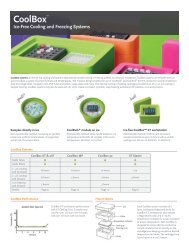Freezing Virus in CoolRack on Dry Ice - BioCision
Freezing Virus in CoolRack on Dry Ice - BioCision
Freezing Virus in CoolRack on Dry Ice - BioCision
Create successful ePaper yourself
Turn your PDF publications into a flip-book with our unique Google optimized e-Paper software.
<str<strong>on</strong>g>Virus</str<strong>on</strong>g> Cryopreservati<strong>on</strong> Protocol 1002<str<strong>on</strong>g>Virus</str<strong>on</strong>g> Cryopreservati<strong>on</strong> ProtocolIntroducti<strong>on</strong>Snap freez<str<strong>on</strong>g>in</str<strong>on</strong>g>g, or flash freez<str<strong>on</strong>g>in</str<strong>on</strong>g>g, is theprocess by which samples are lowered totemperatures below 70°C very rapidly us<str<strong>on</strong>g>in</str<strong>on</strong>g>gdry ice or liquid nitrogen. Snap freez<str<strong>on</strong>g>in</str<strong>on</strong>g>gachieves the same endpo<str<strong>on</strong>g>in</str<strong>on</strong>g>t as slow ratec<strong>on</strong>trolledfreez<str<strong>on</strong>g>in</str<strong>on</strong>g>g, but at approximate rateof10 to 1000°C/m<str<strong>on</strong>g>in</str<strong>on</strong>g>, compared to -1°C/m<str<strong>on</strong>g>in</str<strong>on</strong>g>.Snap freez<str<strong>on</strong>g>in</str<strong>on</strong>g>g with a <str<strong>on</strong>g>CoolRack</str<strong>on</strong>g> module willprovide sample vessel stability, organizati<strong>on</strong>and c<strong>on</strong>sistent freez<str<strong>on</strong>g>in</str<strong>on</strong>g>g parameters, rapidhands-free sample process<str<strong>on</strong>g>in</str<strong>on</strong>g>g while avoid<str<strong>on</strong>g>in</str<strong>on</strong>g>glost or c<strong>on</strong>tam<str<strong>on</strong>g>in</str<strong>on</strong>g>ated samples. Snap freez<str<strong>on</strong>g>in</str<strong>on</strong>g>gis performed <strong>on</strong> a pre-cooled <str<strong>on</strong>g>CoolRack</str<strong>on</strong>g>module, which ensures fast heat transfer.This method can provide excellent specimen<str<strong>on</strong>g>in</str<strong>on</strong>g>tegrity and a wide array of opti<strong>on</strong>s foranalysis, <str<strong>on</strong>g>in</str<strong>on</strong>g>clud<str<strong>on</strong>g>in</str<strong>on</strong>g>g extracti<strong>on</strong> of prote<str<strong>on</strong>g>in</str<strong>on</strong>g>s,DNA and RNA for use <str<strong>on</strong>g>in</str<strong>on</strong>g> research anddiagnostics.This procedure is <str<strong>on</strong>g>in</str<strong>on</strong>g>tended to ensure thatvirus samples collected will be frozen <str<strong>on</strong>g>in</str<strong>on</strong>g> asafe and efficient manner while elim<str<strong>on</strong>g>in</str<strong>on</strong>g>at<str<strong>on</strong>g>in</str<strong>on</strong>g>gthe risks of c<strong>on</strong>tam<str<strong>on</strong>g>in</str<strong>on</strong>g>ati<strong>on</strong> and variati<strong>on</strong> <str<strong>on</strong>g>in</str<strong>on</strong>g>molecular <str<strong>on</strong>g>in</str<strong>on</strong>g>tegrity. The follow<str<strong>on</strong>g>in</str<strong>on</strong>g>g protocoldescribes a general procedure for l<strong>on</strong>g-termstorage of viruses. For each specific virusspecie or stra<str<strong>on</strong>g>in</str<strong>on</strong>g>, always refer to laboratorySOP.Materials• <str<strong>on</strong>g>Virus</str<strong>on</strong>g> preparati<strong>on</strong>• Cryoprotective agent (special cases <strong>on</strong>ly)• CoolBox TM CFT30 ice-free cool<str<strong>on</strong>g>in</str<strong>on</strong>g>g stati<strong>on</strong>• <str<strong>on</strong>g>CoolRack</str<strong>on</strong>g> ® CFT30 module• Cryolabels and/or cryomarkers• ThermalTray LP platform (opti<strong>on</strong>al)• 50ml Reagent Reservoirs• CoolS<str<strong>on</strong>g>in</str<strong>on</strong>g>k ® LX55 (opti<strong>on</strong>al)• CoolBox TM XT (opti<strong>on</strong>al)• TruCool ® cryogenic vials• TruCool h<str<strong>on</strong>g>in</str<strong>on</strong>g>ged cryostorage box• 37°C Waterbath• -80°C Freezer and <strong>Dry</strong> <strong>Ice</strong><str<strong>on</strong>g>Virus</str<strong>on</strong>g> Preparati<strong>on</strong>Follow the laboratory protocol for viral growthand/or purificati<strong>on</strong>. Refer to Centers forDisease C<strong>on</strong>trol and Preventi<strong>on</strong> (CDC)guidel<str<strong>on</strong>g>in</str<strong>on</strong>g>es for utilizati<strong>on</strong> of pathogens <str<strong>on</strong>g>in</str<strong>on</strong>g>specific Biosafety Level (BSL). Pathogens are<str<strong>on</strong>g>in</str<strong>on</strong>g>fectious agents and should always bemanipulated under a biosafety cab<str<strong>on</strong>g>in</str<strong>on</strong>g>et withlam<str<strong>on</strong>g>in</str<strong>on</strong>g>ar flow.<str<strong>on</strong>g>Virus</str<strong>on</strong>g> <str<strong>on</strong>g>Freez<str<strong>on</strong>g>in</str<strong>on</strong>g>g</str<strong>on</strong>g>N<strong>on</strong>-enveloped viruses, some DNA virusesand virus-like particles can be ma<str<strong>on</strong>g>in</str<strong>on</strong>g>ta<str<strong>on</strong>g>in</str<strong>on</strong>g>edstably at 4°C for a relatively l<strong>on</strong>g period oftime. However, RNA and most envelopedviruses are extremely heat labile and need tobe snap-frozen (frozen rapidly) and stored at-80°C for l<strong>on</strong>g-term storage. Please note thatmost viruses will suffer damage if storagetemperatures exceed greater than -60°C.1. As a general rule, ma<str<strong>on</strong>g>in</str<strong>on</strong>g>ta<str<strong>on</strong>g>in</str<strong>on</strong>g> the viralpreparati<strong>on</strong> at 4°C by plac<str<strong>on</strong>g>in</str<strong>on</strong>g>g it <str<strong>on</strong>g>in</str<strong>on</strong>g> areagent reservoir and place the reservoir<strong>on</strong> a thermo-c<strong>on</strong>ductive CoolS<str<strong>on</strong>g>in</str<strong>on</strong>g>k LX55module for uniform and stable cool<str<strong>on</strong>g>in</str<strong>on</strong>g>g.Rest the CoolS<str<strong>on</strong>g>in</str<strong>on</strong>g>k LX55 <strong>on</strong> ice tom<str<strong>on</strong>g>in</str<strong>on</strong>g>imize ice c<strong>on</strong>tact with the reservoirand it’s c<strong>on</strong>tents.2. Dispense 1 mL of the virus preparati<strong>on</strong>*(or desired amount) <str<strong>on</strong>g>in</str<strong>on</strong>g> a pre-labeledTruCool cryogenic vial. To avoid titerreducti<strong>on</strong>, ma<str<strong>on</strong>g>in</str<strong>on</strong>g>ta<str<strong>on</strong>g>in</str<strong>on</strong>g> the vials at 4 o C <str<strong>on</strong>g>in</str<strong>on</strong>g> aCoolBox CFT30 ice-free cool<str<strong>on</strong>g>in</str<strong>on</strong>g>g system.The <str<strong>on</strong>g>CoolRack</str<strong>on</strong>g> CFT30 cryogenic vialmodule <str<strong>on</strong>g>in</str<strong>on</strong>g>side the CoolBox standardizesvial temperature and reducesc<strong>on</strong>tam<str<strong>on</strong>g>in</str<strong>on</strong>g>ati<strong>on</strong> and spill accidents byallow<str<strong>on</strong>g>in</str<strong>on</strong>g>g <strong>on</strong>e-handed open<str<strong>on</strong>g>in</str<strong>on</strong>g>g and clos<str<strong>on</strong>g>in</str<strong>on</strong>g>gof the cryogenic vials while seated <str<strong>on</strong>g>in</str<strong>on</strong>g> the<str<strong>on</strong>g>CoolRack</str<strong>on</strong>g> CFT30 module.*Most virus preparati<strong>on</strong>s c<strong>on</strong>sist of virussupernatants from <str<strong>on</strong>g>in</str<strong>on</strong>g>fected cells cleared of celldebris and therefore c<strong>on</strong>ta<str<strong>on</strong>g>in</str<strong>on</strong>g> enough serum toact as cryopreservants. However, some virusesBioCisi<strong>on</strong>, LLC • 12 E. Sir Francis Drake Boulevard, Unit B, Larkspur, CA 94939 USA • <str<strong>on</strong>g>in</str<strong>on</strong>g>fo@biocisi<strong>on</strong>.com • www.biocisi<strong>on</strong>.com
need an extra cryopreservant agent such as a50% sucrose. Please refer to your laboratorySOP or the literature to assess whether you needto add a special media or cryopreservant to theviral supernatant or preparati<strong>on</strong>.3. While virus samples are kept cold at 4°C<str<strong>on</strong>g>in</str<strong>on</strong>g> the CoolBox CFT30, place a sec<strong>on</strong>d<str<strong>on</strong>g>CoolRack</str<strong>on</strong>g> CFT30 module <strong>on</strong> dry-ice andlet it equilibrate to -78 o C, which takesapproximately five to ten m<str<strong>on</strong>g>in</str<strong>on</strong>g>utes. Note:with this protocol, there is no need tomake a dry-ice/ethanol slurry. Place thecryogenic vials directly <str<strong>on</strong>g>in</str<strong>on</strong>g> the wells of thepre-equilibrated <str<strong>on</strong>g>CoolRack</str<strong>on</strong>g> CFT30 moduleto snap-freeze the samples. This will takeapproximately three to five m<str<strong>on</strong>g>in</str<strong>on</strong>g>utes.4. Transfer the frozen samples to a TruCoolh<str<strong>on</strong>g>in</str<strong>on</strong>g>ged cryostorage box and place it <str<strong>on</strong>g>in</str<strong>on</strong>g> the-80°C freezer for l<strong>on</strong>g-term storage.<str<strong>on</strong>g>Virus</str<strong>on</strong>g> Thaw<str<strong>on</strong>g>in</str<strong>on</strong>g>g1. Transfer the cryogenic vials from the -80°C freezer <str<strong>on</strong>g>in</str<strong>on</strong>g>to a pre-equilibratedCoolBox CFT30 c<strong>on</strong>ta<str<strong>on</strong>g>in</str<strong>on</strong>g><str<strong>on</strong>g>in</str<strong>on</strong>g>g a greenfreez<str<strong>on</strong>g>in</str<strong>on</strong>g>g cartridge <str<strong>on</strong>g>in</str<strong>on</strong>g>side it. This will keepthe vial frozen and allow transport of thevials <str<strong>on</strong>g>in</str<strong>on</strong>g> a safe manner.2. Place the vials directly <str<strong>on</strong>g>in</str<strong>on</strong>g> a 37°C waterbath, and slowly manually agitate thevials to enable the thaw<str<strong>on</strong>g>in</str<strong>on</strong>g>g process. Rightbefore the whole liquid is completelythawed remove the vial from the 37°Cwater bath and place it <strong>on</strong> a <str<strong>on</strong>g>CoolRack</str<strong>on</strong>g>CFT30 module which has been previouslyequilibrated <strong>on</strong> ice. Samples are nowready for desired experimentalprocedures or titer assessment (TCID 50 ,plaque assay, etc.).BioCisi<strong>on</strong>, LLC • 12 E. Sir Francis Drake Boulevard, Unit B, Larkspur, CA 94939 USA • <str<strong>on</strong>g>in</str<strong>on</strong>g>fo@biocisi<strong>on</strong>.com • www.biocisi<strong>on</strong>.com
















